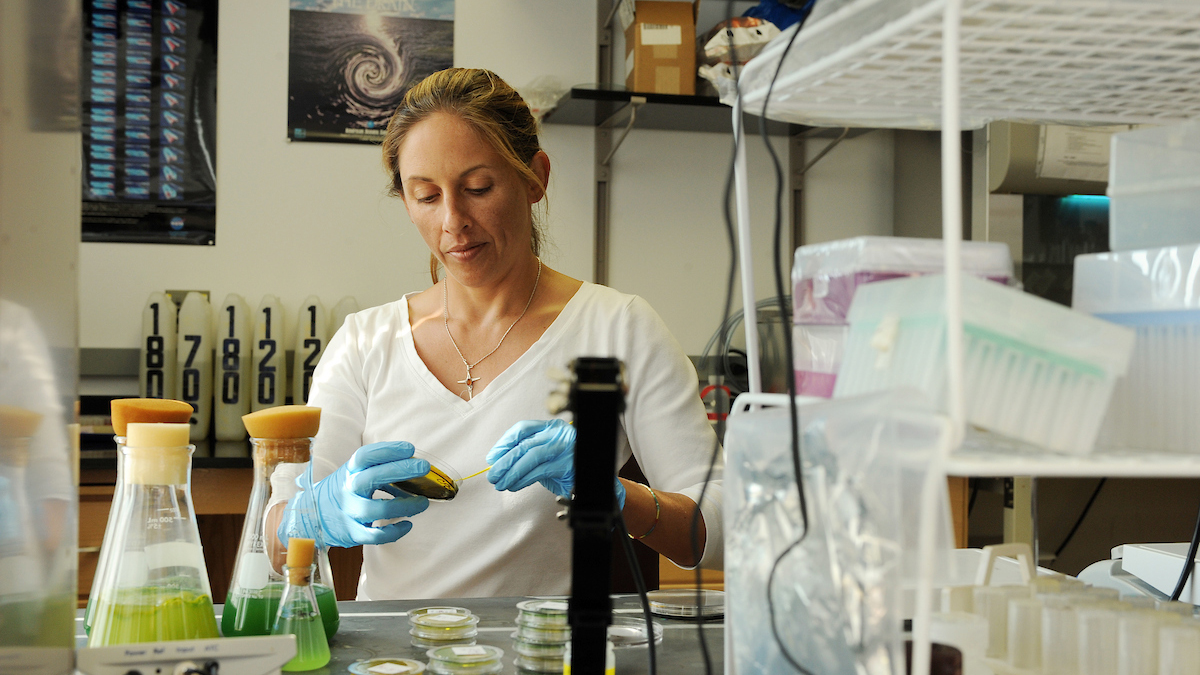Rachel Noble of Carolina’s Institute of Marine Sciences talks about her rapid water quality tests and how they can help North Carolinians stay safe during hurricane season.

Back in 2004, with E. coli commanding attention in the media headlines, Carolina researcher Rachel Noble and partners made a discovery that changed the way the EPA approached water quality testing. While existing methods to measure E. coli in water took 18 to 24 hours for results, Noble’s method could return results in 45 minutes to an hour.
Now she’s working to develop a rapid test to measure bacteria like Vibrio that can be harmful to human health, particularly as they become more prevalent and easier to come into contact with after hurricanes or tropical storms.
As hurricane season kicks off, we talked with Noble about her water quality tests that can be used to keep North Carolinians safe.
What are Vibrio, and why are they a concern during or after a hurricane?
Vibrio are a large group of bacteria that live in estuaries, lakes, rivers, streams and they also live in open ocean environments. There are a few species that are dangerous to humans, and one of the best examples is Vibrio cholerae, the bacteria that causes the disease Cholera. Cholera is not generally a problem in the United States, but it’s a good example of a kind of Vibrio because a lot of people have heard of it.
There are two specific species of Vibrio that we care about in North Carolina and broadly in the United States because they are naturally found in the estuaries of the entire country. Anywhere where you have a mixture of freshwater and saltwater, they tend to be there. In the case of hurricanes, what happens is the system gets exacerbated. Vibrios like warm, brackish water and they love when water has a lot of extra organic material in it. When we have floods, a lot of soil and silt and sediment and material from the land all flows into those estuaries, and Vibrios thrive in those conditions.
What’s the risk to North Carolinians as hurricane season approaches?
The first thing that’s really problematic is that as water from the ocean pushes inward during a hurricane, all of the sudden this salty water gets pushed up into our rivers. So now the area where you actually have a mixture of freshwater and saltwater is expanded inward into all these rivers and creeks and streams. So, areas where people normally wouldn’t be exposed could become exposed to these dangerous Vibrios.
They can make you sick in two ways: If you have an open wound, which many people did after Hurricanes Matthew and Florence, and you become exposed to water that contains a dangerous form of Vibrio, you can become infected very quickly. Those kinds of infections progress very rapidly. But people will think, “Well, my house is underwater. I have other things to do,” so they wait overnight to go to the emergency room. You can also become sick from ingesting Vibrio bacteria, and in that case, the illness is nausea, vomiting, and so forth. Vibrios also love oysters, so you can quickly become ill if you get a wound that’s caused by an oyster shell or if you consume raw seafood.
How did you come up with this new test to identify waterborne contaminants? How does it work?
Using the old methods, we would collect a water sample and we would pass it through a filter that captures the bacteria. Then you’d take that filter and lay it in a Petri dish that contains food specifically designed to grow the Vibrio bacteria. The key to the old, traditional methods is that you have to put it in the incubator overnight, and that takes about 22 to 24 hours. You’re spending more than 90% of that time just allowing those bacteria to grow.
The difference with the test that we’ve designed is that it’s based on the DNA that’s inside the Vibrio bacteria. Each group of bacteria has a DNA signature that is its very own, so we can build a test that allows us to test only for Vibrio DNA in a water sample or from an oyster sample. That’s the same approach we used to design the E. coli test so many years ago, and we can do that test in about 40 to 45 minutes.
What’s your hope for this research in the long-term, both in and outside of the state?
Prior to a hurricane event, during and after, people get exposed to a lot of maps that show them what the wind speed is, the size of the waves, what they can expect as far as storm surge and flood waters, and one of our biggest hopes is that we could begin the process of creating a Vibrio response map. We can measure things like temperature and salinity and create a map where we expect risk to be high, and we can project that to the public to give them information about where there may be a concern for exposure.
The second thing we’d really like to be able to do is to apply some of these new tests better to the areas where we know that we’re growing shellfish to make sure that products in North Carolina are safe. We’re really interested in helping growers identify when and where there’s a risk of Vibrio. In that respect, it’s more related to economics.
We do have an outside industry partner, a multi-national corporation with offices around the world, and we’ve begun to work with them on developing a set of tests that can be commercialized broadly. We are really interested in allowing other areas to benefit from some of the technology we’ve developed here.
I believe as we continue to do a lot of this work on all of these bacteria that can make people sick, we end up naturally developing additional information that provides a structure for being more prepared and becoming part of a disaster response community, anticipating the kinds of problems we might encounter in the future. We’re really trying to reach out and coordinate more with our clinical laboratories and water quality managers to connect our work and make it more valuable in reality, not just in the academic world.
What would you like North Carolinians to know before any future storms hit?
The first thing I would say is that illnesses or infections related to Vibrios are extremely rare. The second is that while they are really rare, they can be serious. The majority of people who get these infections are people who are diabetic or immunocompromised in some other way, like if they happen to be undergoing chemotherapy. This is one of those circumstances where we know we can use technology to respond and do better, and we know we can protect North Carolina products more effectively, but when it comes to thinking about risks, it’s important for people to remain balanced and not be alarmed.
By Emilie Poplett, University Communications




